For centuries, humanity has pondered one of the greatest questions of all time: Are we alone in the universe? Many scientists, astronomers, and fans are fascinated by the search for alien life. This quest has led to exciting discoveries and new theories. Technology is advancing quickly, and research on extraterrestrial intelligence is moving forward. Radio signals from SETI and the discovery of exoplanets in habitable zones make alien life seem closer than ever.
This article looks at recent updates on the search for alien life. It covers the role of SETI research and what new scientific advancements say about extraterrestrial intelligence.
The Search for Alien Life: Where Are We Looking?
The search for alien life spans many scientific areas, like astrobiology and radio astronomy. Researchers explore different potential environments where life could exist beyond Earth.
1. Exoplanets and the Habitable Zone
A key area in the hunt for alien life is exoplanets. These are planets that orbit stars beyond our solar system. Scientists study planets in the habitable zone. This is where conditions might allow liquid water and possibly life.
- Kepler and TESS Missions: NASA’s Kepler Space Telescope found more than 2,600 exoplanets. Many of these are in habitable zones. The Transiting Exoplanet Survey Satellite (TESS) is still on its mission. It finds new candidates for more research.
- Proxima b & TRAPPIST-1 System: Proxima Centauri b is 4.2 light-years away. It lies in the habitable zone of its star. The TRAPPIST-1 system has seven Earth-sized planets. Some of these might support life.
- Super-Earths and Mini-Neptunes: Scientists discovered planets bigger than Earth but smaller than Neptune. These planets might have thick atmospheres and liquid water under their surfaces.
Exoplanets in habitable zones boost the chances of finding alien intelligence or even microbial life.
2. SETI Research: Listening for Signals
SETI, or the Search for Extraterrestrial Intelligence, looks for radio and optical signals. These signals might come from intelligent alien civilizations.
- Breakthrough Listen Initiative: This $100 million project scans the universe for artificial signals. It looks at nearby stars and galaxies to find patterns that stand out from natural cosmic noise.
- The Wow! Signal: In 1977, astronomers recorded a mysterious radio signal from deep space, known as the Wow! Signal. Its origin is still unclear, but it is one of the top candidates for artificial extraterrestrial transmission.
- New Radio Signals from Proxima Centauri: In 2020, astronomers found a strange radio signal from Proxima Centauri. Some researchers think it might come from artificial sources. Natural explanations are still being studied.
- Fast Radio Bursts (FRBs): These powerful but brief radio emissions have puzzled scientists for years. Some think they might be connected to neutron stars. Others believe an advanced alien civilization could use them to communicate.
3. Mars and the Moons of Our Solar System
Closer to home, astrobiologists turn to our own solar system in the quest for microbial life.
- Mars Exploration: NASA’s Perseverance Rover is analysing rock samples for signs of ancient life. Earlier missions found signs of liquid water underground on Mars.
- Europa and Enceladus: Jupiter’s moon Europa and Saturn’s moon Enceladus have subsurface oceans beneath their icy crusts. Water and hydrothermal activity make these moons great places for microbial life.
- Titan – A Unique Possibility: Saturn’s moon Titan has lakes of liquid methane and ethane. Some researchers think exotic life forms might exist there. They could thrive in conditions very different from those on Earth.
Scientific Challenges in the Search for Extraterrestrial Intelligence

Despite significant progress, the search for alien life is filled with challenges and uncertainties.
1. The Fermi Paradox: Where Is Everyone?
Physicist Enrico Fermi famously posed the paradox: If intelligent life is common in the universe, why haven’t we detected it? Several theories attempt to explain this mystery:
- The Great Filter Hypothesis: Suggests that a barrier prevents civilisations from reaching advanced interstellar stages.
- The Zoo Hypothesis: Proposes that advanced extraterrestrial civilisations deliberately avoid contact with us.
- Self-Destruction Theory: Some believe that intelligent civilisations may destroy themselves before achieving interstellar communication.
- Interstellar Distances: The vast distances between stars could make direct communication or travel nearly impossible with current technology.
2. False Positives and Misinterpretations
Many signals initially thought to be of alien origin turned out to have natural explanations. For example:
- Fast Radio Bursts (FRBs) were once considered potential alien signals but are now linked to neutron stars.
- Pulsars were discovered in 1967. At first, they were called “Little Green Men” because of their exact radio pulses. Later, they were recognised as quickly spinning neutron stars.
- Earth-based interference has also been mistaken for extraterrestrial signals, complicating SETI research.
3. Limitations of Current Technology
- Our radio telescopes scan only small parts of the sky. Also, potential alien signals might be weak or use different methods to transmit.
- Space travel limitations mean direct exploration of exoplanets remains beyond our reach, at least for now.
- Even if we received an alien message, deciphering it without a common language or context would be a monumental challenge.
The Future of Alien Life Research

The next decade promises exciting developments in the search for extraterrestrial intelligence.
1. The James Webb Space Telescope (JWST)
Launched in December 2021, JWST offers new insights into exoplanet atmospheres. It searches for biosignatures such as oxygen, methane, and water vapour. These elements could indicate biological processes.
2. Next-Generation SETI Programs
SETI efforts continue to evolve with new technologies:
- AI and Machine Learning: Scientists now use AI to search large datasets for signs of alien signals.
- Optical SETI: Scientists are looking for laser pulses from faraway civilisations, not just radio waves.
- Space-Based Telescopes: Future missions aim to deploy space telescopes dedicated to scanning exoplanets for signs of life.
3. The Breakthrough Starshot Project
This bold plan aims to send small spacecraft to Alpha Centauri. They will be powered by laser beams. Alpha Centauri is our closest star system. If successful, it could provide the first up-close images of an exoplanet beyond our solar system.
Are We Close to an Answer?
The search for alien life continues to be one of humanity’s greatest scientific endeavours. We don’t have clear proof yet. Still, advances in exoplanet discovery, SETI research, and astrobiology bring us closer to answering: Are we alone in the universe?
Future extraterrestrial research looks bright with new missions, advanced technology, and global teamwork. No matter if we find microbial life on an exoplanet or get a signal from space, our search for alien life continues.
What do you think? Could we be on the brink of making contact with extraterrestrial intelligence? Share your thoughts in the comments below!


